What's New
Displaying results 4371 - 4380 of 4914

Resource | Publications,
The HIV epidemic in Indonesia is among the fastest growing in Asia although the aggregate HIV prevalence among adults (15-49 years of age) is still low (0.16%). An estimated 193,000 people were living with HIV as of 2006. The epidemic remains concentrated, in most parts of the country, among groups at high risk: populations sharing injecting equipment and engaging in unprotected sex.
The national commitment to respond effectively to the epidemic is strong. An impressive expansion of the response to the epidemic has been seen in the last two to three years but major disparities exist: geographical, the nature and size of the epidemic, health systems capacity, and available resources.
As part of the process of development of the National Strategic Plan on HIV/AIDS for 2007-2011, the Ministry of Health and the World Health Organization (WHO), in collaboration with a range of partners, organized, from 5 to 17 February 2007, a review of the health sector response to the HIV epidemic in Indonesia. The overall objective was to review progress in the national AIDS programme, especially in areas related to the health sector response, and recommend appropriate measures towards revision of interventions and strategies.
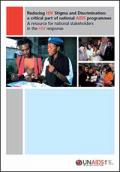
Resource | Publications,
Despite the pervasiveness of HIV-related stigma and discrimination in national HIV epidemics and their harmful impact in terms of public health and human rights, they remain seriously neglected issues in most national responses to HIV.
National AIDS programmes – together with key partners – can take concrete steps to address these
critical obstacles and help pave the way towards universal access to prevention, treatment, care and support. The UN system, funding mechanisms and bilateral partners can support countries – through advocacy, strategic planning, technical assistance, resource mobilisation and other means – to reduce stigma and discrimination related to HIV. These efforts will not only help countries reach key targets for universal access and Millennium Development Goal 6, they will also protect and promote human rights, foster respect for people living with HIV and other affected groups, and reduce the transmission of HIV.

Resource | Publications,
The International Center for Research on Women (ICRW) conducted research in South Asia on emerging efforts in women’s inheritance and property rights as an AIDS response. This special edition is for audiences of the International Congress on AIDS in Asia and the Pacific, which features a Regional Court of Women and symposium on the subject.
In addition to the research outlined in Women’s Property Rights as an AIDS Response, and with input from UNDP, this edition includes a supplementary discussion on the current state of HIV and AIDS in Asia Pacific and the potential pathways of secure property rights for women to mitigate HIV and AIDS.
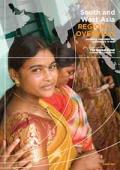
Resource | Publications,
The Global Fund to Fight AIDS, Tuberculosis and Malaria was formed in 2002 in response to the unacceptably high losses from the pandemics. It is a unique global public/private partnership dedicated to the massive scale-up of financing to prevent and treat these diseases in lower-income countries. This partnership between governments, civil society, the private sector and affected communities represents a new approach to international health financing. The Global Fund works in close collaboration with other organizations to supplement and support existing efforts dealing with the three diseases.
The Global Fund’s grant portfolio is organized into eight regions, which are managed by eight corresponding clusters in the Global Fund Secretariat. This overview provides a brief insight into the burden of HIV/AIDS, malaria and tuberculosis in each of these countries and offers a brief description of the Global Fund grants active there. The overview features a number of success stories from these states and shares the latest performance indicators for grants attributed to countries in the South and West Asia region.

Resource | Publications,
In response to concerns over low coverage of HIV testing and counselling in the Asia Pacific region, a "Joint WHO/UNICEF/UNAIDS technical consultation on scaling up HIV testing and counselling in the Asia Pacific" was held in Phnom Penh, Cambodia from 4 to 6 June 2007. The aim of the meeting was to discuss how to scale up HIV testing and counselling services, discuss core public health approaches, ethical principles and human rights values to guide the expansion of HIV testing and counselling, and identify and agree on key actions for follow-up at the regional and country level for policy and programme implementation.
Participants recognized and agreed that there is an urgent need to scale up access to HIV counselling and testing in countries of the region as a means of enhancing access to comprehensive HIV prevention, care and treatment. Existing models of voluntary counselling and testing (client-initiated HIV testing and counselling) need to be strengthened, scaled up and complemented by approaches that can best fit the local epidemiological and social context and build on the potential of health services to offer HIV counselling and testing (provider-initiated HIV testing and counselling). A set of key conclusions and recommendations was agreed on by the consultation participants.

Resource | Publications,
AIDS is an extraordinary disease. As such, it requires an extraordinary response.
In South Asia, the HIV epidemic is heterogeneous in nature. Bangladesh, Nepal and Pakistan have HIV
epidemics that are primarily driven by injecting drug use. India — a country with one of the largest numbers of people living with HIV/AIDS — features an epidemic in its North Eastern region which is primarily driven by injecting drug use. Bhutan, the Maldives and Sri Lanka are countries with growing number of injecting drug users. This document examines whether the laws and policies currently in South Asia are adequate to meet the challenges posed by the threat of HIV/AIDS.
A consistent body of evidence has established that comprehensive HIV prevention programmes which
include needle syringe programmes and oral substitution as part of a comprehensive package reduce drug-related HIV risk behavior (such as needle sharing, unsafe injecting, and frequency of injection). Similarly, there is strong evidence that substitution treatment reduces criminal behavior and illicit opioid use. It also increases treatment retention and improves the overall health status of drug users infected with HIV. These are outcomes which we all seek to promote.
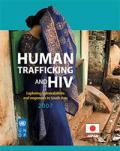
Resource | Publications,
HIV/AIDS and human trafficking threaten human security and human development. Millions of women and girls have been trafficked across borders and within countries in recent years, making human trafficking a global industry that generates an estimated five to seven billion U.S. dollars each year.
In an effort to reduce the dual vulnerabilities of trafficking and HIV among women and girls through greater understanding of the issues and the current state of play in the region, the UNDP RCC convened a Rapid Assessment Studies (RAS) in six South Asian countries: Afghanistan, Bangladesh, India, Nepal, Pakistan and Sri Lanka. The RAS highlights the magnitude, dimensions, causes, consequences and key interventions on HIV/AIDS and human trafficking. The emphasis was on exploring the linkage of the two issues and mainstreaming at different levels of interventions – policy, legislation and programming. A compilation of findings from the RAS is presented in this publication, which highlights the critical links between the two issues and the paucity of data and concerted efforts to address the two together. A number of areas of convergence and joint initiatives have also been identified and recommended.
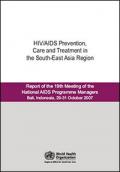
Resource | Publications,
The World Health Organization (WHO) is committed to support Member countries in developing comprehensive and sustainable national AIDS programmes. WHO plays a key role in HIV/AIDS prevention and control in the health sector through providing strategic direction, normative guidance and technical support for national AIDS programmes – through long-term staff in high-burden countries and in-country technical missions.
The National AIDS Programme Managers’ Meeting is an effective forum for sharing experiences between countries, which subsequently leads to strengthening of national AIDS programmes. This annual meeting provides an opportunity for AIDS managers and WHO to review the progress made in AIDS control over the past year, identify and discuss key constraints, formulate possible strategies for replicating successes, and draft plans for the implementation of those strategies at the national and regional level.
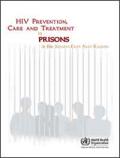
Resource | Publications,
The aim of this review was to gather information relating to HIV prevention, care and treatment in prisons in the WHO South-East Asia Region. Countries selected for inclusion in the review were India, Indonesia, Nepal and Thailand.
South-East Asia is second only to sub-Saharan Africa in terms of estimated numbers of people living with HIV. South-East Asia has also been home to some stunning successes in scaling up HIV prevention, care and treatment interventions. However, the role of HIV transmission in prisons as a key factor for the spread of HIV in the community has largely been ignored. Prisoners are often seen as less deserving of health care or other assistance, particularly when resources are scarce. Yet it must be remembered that prisoners are only temporarily removed from the general community. At some stage, most prisoners will be released and resume living in the community. When prisoners are released, so too are their infections and illnesses.

Resource | Presentations,
Scientific advances over the past 20 years have shown that drug addiction is a chronic, relapsing disease that results from the prolonged effects of drugs on the brain. As with many other brain diseases, addiction has embedded behavioral and social-context aspects that are important parts of the disorder itself. Therefore, the most effective treatment approaches will include biological, behavioral, and social-context components. Recognizing addiction as a chronic, relapsing brain disorder characterized by compulsive drug seeking and use can impact society's overall health and social policy strategies and help diminish the health and social costs associated with drug abuse and addiction.





